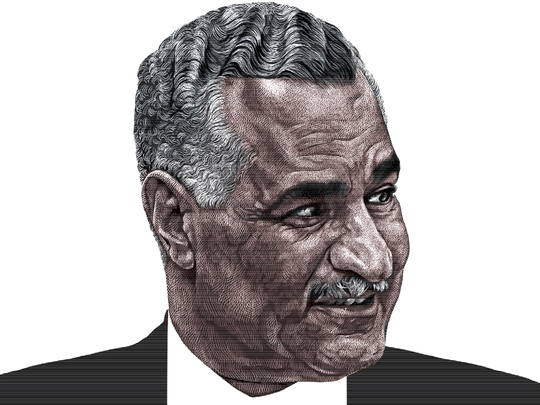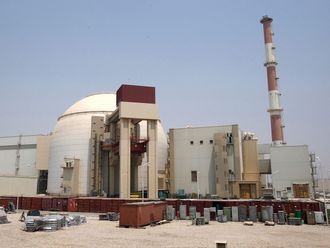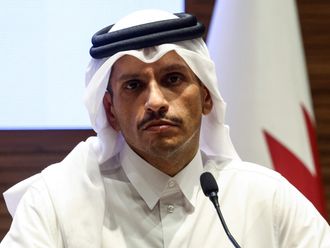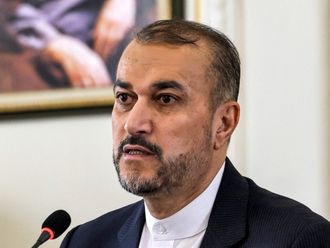
Cairo: Hardly aged 15, Jamal Abdul Nasser, a then high school student, participated in his first anti-government demonstration.
Years later, he recalled the incident, saying:” It was in 1933; at the time I was a student in Alexandria not yet fifteen years old. I was crossing Mansheya Square in Alexandria when I came across a clash between a student demonstration and the police.”
The clash and its consequences apparently remained vivid in Nasser’s memory even after he became Egypt’s president in 1956.
“I hadn’t a moment’s hesitation as to which side I was on. I immediately joined the demonstrators without having the slightest idea as to what they were demonstrating for,” Nasser said in a 1962 interview with David Morgan of Britain’s Sunday Times.
“I recall having thrown a stone in a hopeless gesture but they [police] overtook us in the twinkle of an eye. I tried to escape but as I turned a police baton came down on my head followed by another as I fell. I was taken off to detention along with a number of students who had not been able to escape quickly enough with my head bleeding profusely.”
At the police station, the teenage Nasser asked about the cause of the demonstration and found out it was organised by the opposition Misr Al Fatah Party (Young Egypt) in protest against the government’s policy.
“I entered jail as an enthusiastic student and left fraught with rage. A long time passed before my ideas, beliefs and plans took shape, but even at that early stage I knew my country was embroiled in a continuous struggle for freedom.”
Formative years
A son of a postal worker, as a schoolchild Nasser moved from one school to the other, dictated by his father’s frequent transfers. It was at the Ras Al Teen Secondary School in Alexandria where Nasser experienced his formative years. In those years, he became an avid reader of political books and literature, including works by Egyptian nationalist Mustafa Kamel (1874-1908) and French Enlightenment writer Voltaire (1694-1778).
According to Nasser, he was in particular influenced by “The Return of Soul”, a novel by prominent Egyptian writer Tawfik Al Hakim (1898-1987). Published in 1933, the book argues that the Egyptians, suffering under British colonialisation and corrupt politicians, were in need of a leader, who would unify and lead them in the struggle for freedom and national awakening.
Soon, Nasser displayed talents for writing and acting. He penned an article entitled “Voltaire, the Man of Freedom” printed in his secondary school magazine.
Related: Egyptians remember ‘father of the poor’
In June 1935, Nasser performed in his school’s version of Shakespeare’s “Julius Cesar”, playing the title role.
In 1937, Nasser applied to join the Military Academy, but his application was turned down over his participation in anti-government protests. So, he attended law school at King Fouad University, known today as Cairo University.
He left the law school shortly later and made a new application to join the Military Academy, a bid that proved successful.
At the academy, Nasser came to know Anwar Al Sadat and Abdul Hakim Amer, who later were among his senior aides after he became president.
Having graduated from the Military Academy, Nasser became an infantry officer and served in Sudan, which was part of Egypt at the time.
He also fought in the 1948 Arab-Israeli war over Palestine. He was injured in fighting against Israelis in the Palestinian village of Al Faluja located between the Gaza Strip and Hebron city.
After the war, Nasser worked as a lecturer at the Royal Military Academy in Egypt and started contacts with the Muslim Brotherhood, a major Islamist group at the time, to forge an alliance.
Later, he distanced himself from the Brotherhood because he found out that their agenda was different from his nationalist and anti-monarchy objectives.
In 1945, Nasser secretly formed a group of young army officers, calling itself the Free Officers Movement comprising Al Sadat and Amer.
Their aims included toppling the monarchy, ending the British occupation of Egypt, setting up a strong national army and establishing social justice.
Nasser managed to enlist support of Mohammad Najeeb, a senior army commander, for the nascent movement.
Cracks in the revolutionary house
Late on July 22, 1952, the Free Officers surprisingly seized key state institutions, including the radio stations and the army headquarters in Cairo.
On the following morning, they announced in a radio statement the success of their anti-monarchy action.
The young revolutionaries compelled the then King Farouk to abdicate in favour of his six-month-old son Ahmad Fouad and to leave the country on a royal yacht for Italy.
On June 18, 1953, they abolished the monarchy and named Najeeb as the first Egyptian president and a prime minister.
Nasser was named a deputy prime minister and the interior minister.
Amer was appointed as the general commander of the army.
Now in power, the young revolutionaries introduced agrarian reforms that turned millions of poor farmers into landlords.
But it was not long before a dispute erupted between Najeeb and the young revolutionaries. They resented his way of governing and his demands that the military hand over power to civilians and the multi-party system revived.
Nasser and his loyalists on the powerful Revolution Command Council also followed with suspicion Najeeb’s contacts with opponents, including the Muslim Brotherhood and the disbanded liberal Al Wafd Party.
In February 1954, Najeeb announced his resignation from the Revolution Command Council in protest against its meeting in his absence.
Nasser put Najeeb under house arrest. The council appointed Nasser as its head and a prime minister. But under pressure from pro-Najeeb loyalists who staged street rallies in his support, he was reinstated.
Months later, Najeeb was forced to resign by his opponents on the Revolution Command Council, who put him again under house arrest where he and his family remained until Nasser’s successor—Al Sadat—released them in 1971.
Crackdown on the Brotherhood
In October 1954, Nasser survived an assassination attempt while he was delivering a speech in Alexandria, Egypt’s second biggest city.
The gunfire missed Nasser, who continued his speech with a fiery improvisation. “Oh people! Oh, free men! Jamal Abdul Nasser belongs to you. My blood is for you. I’ll live for you and die for your service. I’ll live in order to struggle for your freedom and dignity,” he said, further inflaming his audience.
Related: Abdul Nasser’s life in short
The assassination attempt was blamed on the Muslim Brotherhood, which was banned and became the target of a draconian security crackdown in the aftermath. Thousands of Brotherhood followers were rounded up.
Nasser’s popularity grew as he championed massive socio-economic reforms for the Egyptians and advocated pan-Arabism.
In June 1956, he became Egypt’s president, a post he held until 1970.
Taking on the West
In July 1956, Nasser nationalised the Suez Canal, a major international waterway, in order to use its revenues for building the hydro-electric High Dam in Upper Egypt after the World Bank refused to finance the construction that he deemed necessary for the country’s agro-industrial development.
Nasser’s move angered Britain and France, which together with Israel, unleashed a military attack on Egypt in October 1956. Under international pressure, the triumvirate were eventually forced to withdraw from Egypt.
Short-lived merger
In early 1958, Nasser agreed to a merger between Egypt and Syria in order to stave off an alleged plot by communists in the latter to seize power. The merger was officially declared on February 1 of that year under the name of the United Arab Republic (UAR). Weeks later, Nasser made a surprise visit to Damascus where thousands of people took to the streets to welcome him.
However, opposition to the merger later grew inside Syria due to the Egyptian officials’ misguided policies there that resulted in economic problems.
Related: Syrian politicians recall mass adoration of Nasser
In September 1961, separatists in the Syrian army staged a coup and declared secession of the country from the UAR. Nasser soon bowed to the move, saying he does not want to see an inter-Arab fighting. The merger collapse dealt a harsh blow to Nasser’s pan-Arab ambitions, according to insiders.
“Nasser’s health started to deteriorate after the union’s dissolution. He also became a chain-smoker,” leading Egyptian journalist Hassanein Heikal, a confidant of Nasser, once wrote.
Contested nationalisation drive
In the early 1960s, Nasser initiated a large-scale nationalisation programme that targeted privately owned business and the media. His aims were to give the working class and the poor access to free public services as part of an ambitious socialist policy.
Critics, however, say that the move harmed Egypt’s economy, which became centrally controlled and overstaffed, besides muzzling freedom of expression.
Reshaping world ties
Since the 1956 Suez Crisis, Nasser had become an international name. In 1961, he founded with Jawaharlal Nehru of India, Yugoslav leader Josip Broz Tito and Sukarno of Indonesia the Non-Aligned Movement (NAM) with the aim of espousing neutrality in the Cold War era, promoting world peace and cementing links among the developing countries. Nasser steered the bloc’s helm for six years starting from 1964.
Shattering defeat
Nasser’s political demise is widely believed to have occurred in June 1967 when Egypt suffered a humiliating military defeat by Israel.
On June 5, 1967, Israeli warplanes crippled down grounded fighter jets and destroyed airbases.
The surprise Israeli attack robbed Egypt of its Sinai Peninsula and brought Israeli troops to the bank of the Suez Canal, a major waterway that connects the Mediterranean Sea and the Red Sea.
Related: Nasser’s revolutionary spirit passed onto his children
The defeat dealt a shattering blow to Nasser’s charismatic leadership.
A few days after the news of the rout became public news, Nasser announced his resignation in a solemn TV speech. But massive street demonstrations prompted him to revoke his decision and remain in office until death in 1970.
Historic farewell
At the end of a pan-Arab summit in Cairo on September 28, Nasser suffered a heart attack. He was taken to his house where he died hours later. His sudden death stunned his loyalists in Egypt and other parts of the Arab world. Grief-stricken, around five millions converged on Cairo and attended his funeral, regarded as one of the biggest in modern history.
Etched on mind and soul
Despite his hypnotic leadership, Nasser was always touched whenever he was reminded of his mother, who died while he was eight years old.
He learnt about her departure in Alexandria weeks later as he was a pupil at a primary school in Cairo.
“Losing my mother was a very sad experience in itself, losing her in that way was traumatic and it left a scar that time could not heal,” he said in the Sunday Times interview.
“My personal pain and sorrow I experienced at the time made it very distasteful to me to inflict pain and sorrow on others in the subsequent years.”
They said what on Nasser
Nasser’s successor, Al Sadat, had much to say about him. In a gesture of admiration for Nasser, Al Sadat named his son Jamal. Al Sadat also entitled his memoirs “My Son, This Is Your Uncle, Jamal”, which takes the shape of letters that Al Sadat began writing two months after the birth of his son in November 1956.
In the book published in 1965, he describes Nasser as characteristically faithful, calm, strict with himself and forgiving of others.
“He knows well what he wants. He does not make up his mind until deep thinking. If he becomes resolute, none of all forces on the Earth will make him change his mind,” writes Al Sadat.
However, eight years later, Al Sadat criticised Nasser’s regime for a “legacy” of hate, including alleged massive rights abuse and the 1967 military defeat by Israel. Sadat’s U-turn angered Nasser’s family and millions of the late leader’s devotees.
There was a similar reaction some months ago towards Egypt’s ex-foreign minister Amr Moussa.
In his memoirs “My Testimony”, published in Cairo in September, Moussa criticises Nasser’s rule. Moussa particular drew fire from Nasserists for writing that Nasser imported food from Switzerland because he was on a dietary weight-reducing regime. Moussa, who worked at the time at the Egyptian embassy in Switzerland, adds that a man used to come to the embassy to take delivery of the food from him.
Nasser’s confidant, Samy Sharaf, disputed Moussa’s account.
“It did not happen even once that Abdul Nasser ordered his food from Switzerland,” Sharaf, who served as Nasser’s secretary, told a local television station. “Abdul Nasser did not even import his medicine from abroad. I challenge him [Moussa] if he can prove his allegations.” Nasser was a diabetic.
Downplaying the furore, Moussa later, said: “What is wrong if the president ordered a medicinal food from abroad? This food was not available at the time in Egypt. There was nothing bad about this.”












